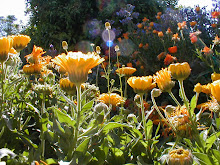- 4 to 6 small zucchini, or summer squash about 1.5 pounds
- salt
- 3 tablespoons chopped fresh mint or basil
- 2 tablespoons chopped fresh flat-leaf parsley
- 2 large cloves garlic, minced
- 6 tablespoons olive oil
- 4 tablespoons red or white wine vinegar
Cut the zucchini into 1/4 inch thick slices, or to prepare it Veneto fashion, cut the zucchini lengthwise into 1/4 inch thick slices. Sprinkle with salt and let stand in a colander for 30 minutes to drain off any bitter juices. Rinse and pat dry. In a small bowl, combine the mint or basil, parsley, and garlic. Warm the olive oil in a frying pan over medium-high heat. In batches, add the zucchini and cook, turning as needed, until golden on both sides, 4 to 5 minutes. Transfer to a shallow serving dish and sprinkle with some of the mint mixture and some of the vinegar. Repeat with the rest of the zucchini, mint mixture, and vinegar. Leave at room temperature for 1 to 2 hours, basting occasionally with vinegar in the dish, before serving.

